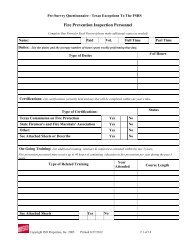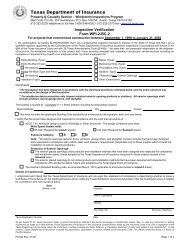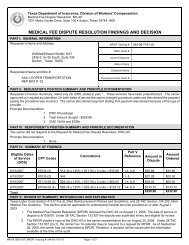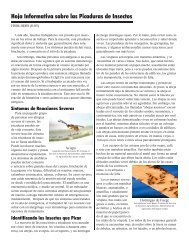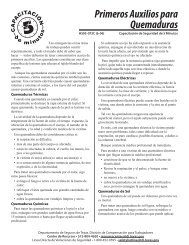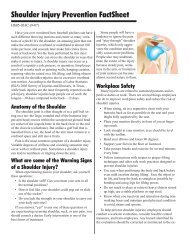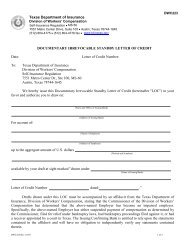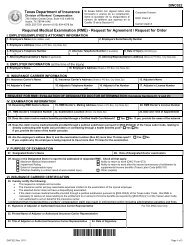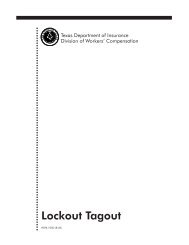Windows - Texas Department of Insurance
Windows - Texas Department of Insurance
Windows - Texas Department of Insurance
You also want an ePaper? Increase the reach of your titles
YUMPU automatically turns print PDFs into web optimized ePapers that Google loves.
TEXAS DEPARTMENT OF INSURANCE<br />
Engineering Services / MC 103-3A 333 Guadalupe Street P.O. Box 149104 Austin, <strong>Texas</strong> 78714-9104<br />
Phone No. (512) 322-2212 Fax No. (512) 463-6693<br />
Submittal Requirements for Product Evaluation - <strong>Windows</strong><br />
The information and product requirements requested below will be used by the <strong>Texas</strong> <strong>Department</strong> <strong>of</strong> <strong>Insurance</strong><br />
(TDI) to develop a product evaluation report for exterior windows for use in the designated catastrophe areas<br />
along the <strong>Texas</strong> Gulf Coast. The product evaluation report will identify the product, specify the maximum design<br />
pressure limitations, specify the wind zones where windborne debris resistant products may be used (if applicable<br />
to the product), specify the applicable component dimensions, describe the tested assembly, specify the<br />
applicable installation methods, and specify the fastener specifications used. There is no fee for the evaluation <strong>of</strong><br />
the product by the TDI. This evaluation is not intended to preclude a <strong>Texas</strong> licensed pr<strong>of</strong>essional engineer from<br />
using testing information or ICC evaluation reports that have not been submitted to the TDI for certifying<br />
compliance with the building specifications adopted by the TDI.<br />
1.0 Minimum Information Required for Evaluation<br />
The information requested must be provided in the form <strong>of</strong> a complete and organized package. The<br />
package must be mailed to the <strong>Texas</strong> <strong>Department</strong> <strong>of</strong> <strong>Insurance</strong> at the address shown at the top <strong>of</strong> this<br />
document. The submittal must include a cover letter and the substantiating information specified in Section<br />
5.0. The cover letter needs to include the following:<br />
1.1 Full name and address <strong>of</strong> manufacturer.<br />
1.2 Manufacturer’s engineering or technical representative contact, including telephone number, fax<br />
number, and e-mail address.<br />
1.3 Manufacturer’s contact phone number for local sales information.<br />
1.4 The name (model, series number, etc) <strong>of</strong> the product(s) that are to be listed.<br />
1.5 Indicate whether the products are impact resistant or non-impact resistant.<br />
1.6 A description <strong>of</strong> the substantiating information as specified in Section 5.0 for each product included in<br />
the submittal.<br />
1.7 Optional: Provide an electronic version <strong>of</strong> a draft TDI product evaluation report.<br />
1.8 Optional: Electronic drawings that illustrate the construction and installation <strong>of</strong> the product(s) and are<br />
consistent with the submitted test data or evaluation information requested by the manufacturer.<br />
Drawings will be included in the evaluation to provide guidance and to clarify the use <strong>of</strong> the product in<br />
the field. Provide one (1) hard copy <strong>of</strong> the drawings and one (1) electronic copy (PDF) saved to a CD<br />
or DVD. The TDI may use the electronic copy to post the drawings on the TDI Windstorm Inspection<br />
Program Product Evaluation Index website.<br />
1.9 Indicate if the submitted information is regarding a new product evaluation or the revision <strong>of</strong> an existing<br />
evaluation. If the information is for a revision, please indicate the existing TDI evaluation number.<br />
2.0 Building Code Requirements for Products<br />
2.1 Products will be evaluated by the TDI according to the wind load criteria <strong>of</strong> Chapter 3 <strong>of</strong> the 2006<br />
International Residential Code (IRC); the wind load criteria <strong>of</strong> Section 1609 <strong>of</strong> the 2006 International<br />
Building Code (IBC); test standards; performance criteria; and labeling requirements referenced in the<br />
IRC and the IBC and the <strong>Texas</strong> Revisions to the IRC and the IBC; and nationally recognized test<br />
standards or procedures.<br />
2.2 Basic design wind speed requirements for construction in the designated catastrophe areas along the<br />
<strong>Texas</strong> Gulf Coast are as follows:<br />
<strong>Texas</strong> <strong>Department</strong> <strong>of</strong> <strong>Insurance</strong> Page 1 <strong>of</strong> 4<br />
April 2013
Submittal Requirements for Product Evaluation - <strong>Windows</strong><br />
• Inland II Zone: 110 mph, 3-second gust<br />
• Inland I Zone: 120 mph, 3- second gust<br />
• Seaward Zone: 130 mph, 3-second gust<br />
2.3 Design Pressure Requirements: The exterior window product must have a minimum design pressure<br />
rating <strong>of</strong> 25 psf. Refer to either Table R301.2(2) <strong>of</strong> the IRC or ASCE 7 for design wind pressure<br />
requirements. The manufacturer should consider that Exposure B and C conditions can occur in each<br />
wind zone.<br />
2.4 Windborne Debris Requirements: For construction in the Inland I Zone, glazed exterior opening<br />
products must either be designed to resist windborne debris or be protected from windborne debris by<br />
an impact protective system. For construction in the Seaward Zone, all exterior opening products must<br />
either be designed to resist windborne debris or be protected from windborne debris by an impact<br />
protective system.<br />
3.0 Product Applicability and Limitations <strong>of</strong> Evaluation Report<br />
3.1 Evaluation <strong>of</strong> a product does not constitute approval <strong>of</strong> the product for use on all structures. The<br />
design pressure rating <strong>of</strong> the product (as reported in the TDI evaluation) must exceed the required<br />
design pressure required for the specific structure. In addition, the windborne debris resistance rating<br />
for the product (as reported in the TDI evaluation) must comply with the required windborne debris<br />
criteria for the specific structure.<br />
3.2 The TDI will develop the product evaluation report based on the manner in which the product was<br />
tested. This includes the attachment <strong>of</strong> the product to the test buck and the material used for the test<br />
buck. NOTE: Products should be tested as they would be installed in the field. Products should be<br />
tested with a test buck or framing utilizing common framing materials and be attached to the test buck<br />
or framing with readily available, commonly used fasteners.<br />
3.3 If the window product is tested with fasteners penetrating through a nailing fin, such as for new<br />
construction windows and a frame installation option is desired (such as for replacement windows),<br />
then a fastener analysis may be submitted to the TDI. The fastener analysis must include the<br />
following:<br />
• The analysis must include the fastener type, size, and spacing along the window frame.<br />
• The analysis must include the minimum species <strong>of</strong> lumber required for the wall framing.<br />
• The analysis must specify the minimum penetration <strong>of</strong> the fastener into the wall framing.<br />
• The analysis must utilize the NDS for withdrawal and shear.<br />
• The analysis must be signed, sealed, and dated by a <strong>Texas</strong> licensed pr<strong>of</strong>essional engineer.<br />
3.4 Window products tested as individual windows will be listed in the TDI evaluation as individual<br />
windows. Window products tested as mulled assemblies will be listed in the TDI evaluation as mulled<br />
assemblies. If a mulled assembly listing is desired for a product that was tested as an individual<br />
product, then the product shall either be tested as a mulled assembly or a mullion analysis may be<br />
submitted to the TDI. If the product is tested, then the product may be tested in accordance with<br />
Section 4.0 <strong>of</strong> this document or AAMA 450. If a mullion analysis is to be submitted, then the mullion<br />
analysis must include the following:<br />
• The analysis must be conducted in accordance with Section R613.9 <strong>of</strong> the 2006 IRC.<br />
• The analysis must specify how the mullion is secured to the wall framing (include the fastener<br />
type, size, spacing, quantity and penetration distance into the wall framing. Also specify the<br />
species required for the wall framing).<br />
• The analysis must specify how the window frames are secured to the mullion (include the<br />
fastener type, size, location, and spacing).<br />
• The analysis must be signed, sealed, and dated by a <strong>Texas</strong> licensed pr<strong>of</strong>essional engineer.<br />
<strong>Texas</strong> <strong>Department</strong> <strong>of</strong> <strong>Insurance</strong> Page 2 <strong>of</strong> 4<br />
April 2013
Submittal Requirements for Product Evaluation - <strong>Windows</strong><br />
4.0 Testing and Test Report Minimum Information Requirements<br />
4.1 Testing Facility- Test reports shall be developed by testing facilities that comply with one <strong>of</strong> the<br />
following:<br />
4.1.1 The test facility shall be either UL (Underwriters Laboratories) <strong>of</strong> FM (Factory Mutual),<br />
4.1.2 The test facility shall be recognized by the International Code Council Evaluation Service (ICC-<br />
ES) as specified in ICC-ES Acceptance Criteria AC85,<br />
4.1.3 The test facility shall be accredited by either AAMA or WDMA,<br />
4.1.4 The test facility shall be recognized by Miami-Dade County, Florida, or<br />
4.1.5 The test facility shall be accepted by the <strong>Texas</strong> <strong>Department</strong> <strong>of</strong> <strong>Insurance</strong>. The <strong>Texas</strong><br />
<strong>Department</strong> <strong>of</strong> <strong>Insurance</strong> will accept test facilities that are accredited as complying with<br />
ISO/IEC Standard 17025 by the International Accreditation Service (IAS) or by any other<br />
accreditation body recognized by the International Laboratory Accreditation Cooperative<br />
(ILAC) Mutual Recognition Agreement (MRA). The scope <strong>of</strong> the accreditation shall include the<br />
type <strong>of</strong> testing covered in the submitted test reports.<br />
Manufacturer’s test facility: If the manufacturer performs in-house testing, then the manufacturer shall<br />
have the testing conducted under the supervision <strong>of</strong> an independent testing facility that qualifies under<br />
Sections 4.1.1 through 4.1. The test report shall be prepared by and issued by the supervising party.<br />
The <strong>Texas</strong> <strong>Department</strong> <strong>of</strong> <strong>Insurance</strong> reserves the right to request that the testing facility provide<br />
documentation to verify compliance with Sections 4.1.1 through 4.1.5.<br />
4.2 Window products shall be tested and bear a label indicating compliance with AAMA/WDMA/CSA<br />
101/I.S.2/A440 as specified in Section R613.4 <strong>of</strong> the 2006 IRC and Section 1714.5.1 <strong>of</strong> the IBC.<br />
4.3 Windborne Debris Testing: If a window product is to be listed as windborne debris resistant, then in<br />
addition to complying with Section 4.2 <strong>of</strong> this document, the window product must also be tested in<br />
accordance with ASTM E 1886 and ASTM E 1996 or in accordance with AAMA 506 and bear a label<br />
indicating compliance with either AAMA 506 or ASTM E 1886 and ASTM E 1996 and indicate the<br />
missile level and design pressure rating.<br />
4.4 Test Reports: The test report shall be developed by the independent test laboratory. The test report<br />
shall include the following minimum information:<br />
• Date <strong>of</strong> testing<br />
• Date <strong>of</strong> report<br />
• Test standards for which the product was tested<br />
• Description <strong>of</strong> the product to include model, series or product name.<br />
• Overall dimensions <strong>of</strong> the tested assembly.<br />
• Component dimensions <strong>of</strong> the tested assembly (such as sash or vent sizes)<br />
• Size <strong>of</strong> the fixed daylight opening in single hung and horizontal sliders.<br />
• Description <strong>of</strong> the tested assembly.<br />
• Frame construction, including corner construction.<br />
• Glass construction and glazing method.<br />
• Hardware description, quantity, and locations<br />
• Reinforcement requirements (material, dimensions, and location in the assembly)<br />
• The species <strong>of</strong> the lumber used for the test buck (the lumber that the window was secured to<br />
during testing).<br />
• Description <strong>of</strong> fasteners used during testing to secure the product to the test buck. Include<br />
fastener type, size, length, and spacing.<br />
• Test result criteria as required by the applicable test standard.<br />
<strong>Texas</strong> <strong>Department</strong> <strong>of</strong> <strong>Insurance</strong> Page 3 <strong>of</strong> 4<br />
April 2013
Submittal Requirements for Product Evaluation - <strong>Windows</strong><br />
5.0 Substantiating Information<br />
5.1 The following information must be included as part <strong>of</strong> the submittal package for each product to be<br />
listed:<br />
• Cover letter as described in Section 1.0.<br />
• Test report in accordance with AAMA/WDMA/CSA 101/I.S.2/A440<br />
• Optional: Lab stamped drawings that go with the AAMA/WDMA/CSA 101/I.S.2/A440 test report<br />
(Provide if requested by the TDI during review process).<br />
• Test report in accordance with either AAMA 506 or ASTM E 1886 and ASTM E 1996 (required for<br />
windborne debris resistant products).<br />
• Optional: Lab stamped drawings that go with the AAMA 506 or ASTM E 1886 and ASTM E 1996<br />
test report (Provide if requested by the TDI during the review process).<br />
• Copy <strong>of</strong> the label that will be applied to the window product. The label shall be in accordance<br />
with Section R613.4 <strong>of</strong> the 2006 IRC or Section 1714.5.1 <strong>of</strong> the 2006 IBC. The label shall be<br />
from an inspection agency (AAMA, WDMA, NAMI, or Keystone). NOTE: For windborne debris<br />
products, the label shall also indicate compliance with either AAMA 506 or ASTM E 1886 and<br />
ASTM E 19896 and specify missile level.<br />
• Copy <strong>of</strong> the certification document from the inspection agency for the tested product. Examples<br />
include the following:<br />
o Authorization for Product Certification (AAMA)<br />
o Notice <strong>of</strong> Product Certification (NAMI)<br />
o Hallmark Certificate <strong>of</strong> Conformance and License (CCL) (WDMA)<br />
o Certification Authorization Report (CAR) (Keystone)<br />
NOTE: The label provided must match the criteria specified on the certification document.<br />
• Installation instructions.<br />
6.0 Expiration and Renewal <strong>of</strong> Evaluation Reports<br />
6.1 Certification <strong>of</strong> the product by the inspection agency shall be current.<br />
6.2 The TDI will utilize a test report for a maximum <strong>of</strong> ten (10) years from the product test date as indicated<br />
in the test report as long as the product is certified by the inspection agency and the test report is<br />
current.<br />
6.3 If the test report indicates an expiration date and the test report is expired, then the test report shall be<br />
revised to either (1) remove the expiration date, (2) change the expiration date, or (3) add a record<br />
retention date.<br />
6.4 If the test report indicates an expiration date and the test report is within six (6) months <strong>of</strong> expiring,<br />
then the TDI reserves the right to request that the test report be revised to either (1) remove the<br />
expiration date, (2) change the expiration date, or (3) add a record retention date.<br />
6.5 For an initial product evaluation, if the test report does not indicate an expiration date or if it specifies a<br />
record retention date, then the TDI reserves the right to refuse to utilize the test report if the test<br />
laboratory is not able to provide information relative to the testing <strong>of</strong> the product specified in the test<br />
report.<br />
6.6 For the renewal <strong>of</strong> an existing product evaluation, if the test report does not indicate an expiration date<br />
or if it specifies a record retention date, then the TDI may continue to utilize the test report if no<br />
changes have occurred in the product.<br />
6.7 The evaluation report will expire four (4) years from the effective date <strong>of</strong> the evaluation report or when<br />
the certification from the inspection agency (AAMA, WDMA, NAMI, or Keystone) <strong>of</strong> the products listed<br />
in the evaluation report expires, whichever is less time.<br />
6.8 The expiration date for the evaluation report shall be based on the date the product was tested as<br />
indicated in the test report.<br />
6.9 The evaluation report will indicate the month and year <strong>of</strong> the expiration date.<br />
<strong>Texas</strong> <strong>Department</strong> <strong>of</strong> <strong>Insurance</strong> Page 4 <strong>of</strong> 4<br />
April 2013



